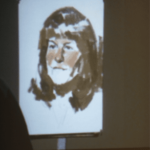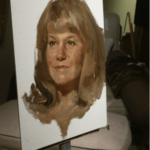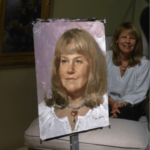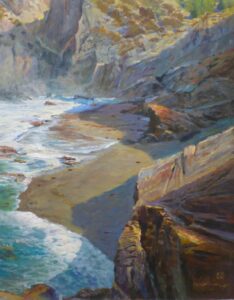
40″x30″
This message is for “art-makers”.
In our world today, no justification is needed for cultural activities, performances, museums, books, the enjoyment of children’s imaginative play, or the process of the creative act. And for those who “make art”, there are a variety of reasons to create. For some, art-making is a past-time, and for others a hobby. Still others consider it to be a vocation. At any level, it may be developed, refined and appreciated.
“All great art is but a vision of creation”. Manfred Khyber
But what is Art for, and where does it come from? We have just experienced a season of gift-giving, and are moving toward goal-setting for the new year. As artists, how exactly will art fit in to our own lives and plans?
This message, too, is for”art-makers”: your Art is a gift. That’s with a capital “A”, because I know your art is important to you, just as mine is to me. But it’s not precisely your art, or my art: the capacity and ability to create art is not an innate skill. It’s a gift, as Edward Yang puts it, for stimulating and “inspiring human flourishing”. It’s a gift that keeps on giving, as long as we keep practicing and giving it. It is a gift we may give to ourselves, to others, to the future, and to our Creator, who made us and gave the gift to us.
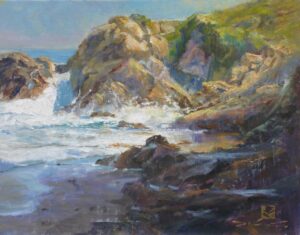
14″x18″
Art-making is a gift to ourselves
Making art reinforces and feeds our naturally-curious and creative nature. Through it, artists liberate the imagination, which itself is a gift: we can go wherever we want, any time we want. We enjoy the mixing and mashing of materials to make something new, something that has never been made before. We find fulfillment and freedom through art-making, as our skills and knowledge grow, along with our personality and level of accomplishment.
͞”The greatest good one can do for another is not just to share one’s riches, but to reveal to him his own”. Benjamin Disraeli
Art-making is a gift to others
Our art can provide a lens through which others might see the truth. That’s the usefulness of both metaphors and poetic license. Art is a window to reality, and we know that reality is not just visual. Poet and author Antoine de Saint-Exupery believed that “What is essential is invisible to the eye”. Another philosopher, Aristotle, also believed: “The aim of art is to represent not the outward appearance of things, but their inward significance”. Art can better equip people to deal with their trials, issues, and challenges: have you ever seen a movie, or heard a piece of music, that made you feel differently about something; maybe, so differently that you wanted to change your life after having seen or heard it? Artworks can point the way to hope, grace, and love in a world full of tragedy, suffering and death: that’s the power of art and the artist. “Art should not duplicate real life as it is—Art can and should reveal the artist’s vision of life as it could be”, opines Jennifer King, a contemporary artist. As Leland Ryken writes, “In art we find the materials of life simplified, rearranged, and heightened”. The artist can shine light into the lives of those who are struggling to find a way out—or a way in.
“Artists create things which last beyond death—they are offering something to future generations”. Rollo May
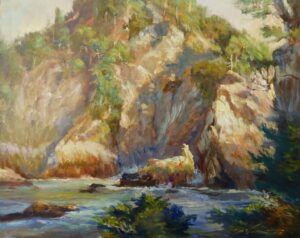
16″x20″
Art-making is a gift to the future
People long to see beauty in the world. Wars slash across the globe like lightning storms, populations everywhere are decimated by drought, hunger and privation, floods claim homes and cities, fires ravage forests and in some places, only ruins tell the tale of what was once a bright architectural vision. In the midst of it all, writes aesthetics philosopher Rollo May, artists “hold up͞that aspect of beauty that transcends death…such as eternity, serenity, and the use of the imagination to project us beyond time and space. The artist leaves a gift for us and the future”. Michelangelo’s Sistine Chapel ceiling continues to testify of his visions of the origins of man and the universe; Brancusi’s “Bird in Space” is both a record and precursor of the wonders of flight; and the spectacular paintings of Thomas Moran and Albert Bierstadt were instrumental in the governmental planning of America’s national parks, which millions from around the world enjoy today.
Art-making is a gift to the Giver
As artists, we can be grateful for the gift we have been given, since it is not of ourselves, nor of our own making. And we can be thankful for what author Franky Schaeffer terms “the longing to understand and enjoy what is around us”. We can also be appreciative for the opportunity to provide some insight, hope, and pleasure to those who view our work. And we can humbly wear the honor of being able to serve humanity as artists, to make a creative product or perform a needed service for others. As Edward Yang concludes, “The vocation of an artist is not to be valued solely on usefulness, but in sharing with others the gift of the Giver.”
Painting the Perfect Subject
Is there such a thing—the “perfect” subject to paint– on any given day?
Like song-choice for a musician, the subject an artist chooses to paint carries his/her personality, abilities and message to the viewers who will see it. Possibilities abound: perhaps a 300-foot tumbling waterfall, the sun poised on a dramatic orange horizon, or that striking profile of a most beautiful model. What really makes for a “perfect” subject?

Let’s see what some other artists say on that “subject:”
“The subject itself is no account; what matters is the way it is presented.” (Raoul Dufy)
“Content is more than ‘subject matter.’ It is all the feelings and ideas you bring to your painting.” (Rene Huyghe)
“There has to be that magical ‘urge’ and excitement to paint the subject, or it just will not work.” (Randall Sexton)
“Just because it is there, doesn’t mean you have to paint it.” (CJ Rider)
Is there such a thing—the “perfect” subject to paint– on any given day?

When choosing what to do next in their college courses, or in their personal lives, or in their careers, I have told my daughters, “choose to W.I.N.” Ask yourselves, “What’s Important Now?” –then do that. That is an aid to stay focused, look at the Big Picture, and avoid getting frustrated or sidelined by details.


“It is only with the heart that one can see rightly.” – Antoine de Sainte-Exupery
The Hand of a Master: Portrait Demo by Mian Situ

Just as significantly as seeing a quality artwork created are the intangibles communicated to onlookers, through the hairs of the artist’s brush directly into the minds and hearts of the spectators.
This is precisely what occurred on the occasion of Mian Situ’s June demonstration for the Orange County Chapter of the California Art Club at the Higbee Gallery in Costa Mesa, California. Fifty artists and collectors were treated to Mian’s process in creating a portrait of Linda Stern, wife of Jean Stern, executive director of the Irvine Museum.


“Show your soul—paint what you know.”Mian Situ
This night, Mian started with a delicate but deliberate drawing in charcoal, held at the very end as he blocked in the portrait with angular marks, some long, some short.
Then, using a dark earth color, he carefully placed the darks at the edges of the cheeks and nose, in the hair, and indicated the shapes of both eyes and eyebrows.
Medium-value flesh tones were laid in, with reds featured across the eyes, nose and cheeks. Mian’s intense observation created a complex system of grays in the skin tones, as he left highlights, blouse and jewelry for last. The way he handled the brush indicated deliberation in each stroke. Mian’s concentration was focused, his strokes confidently placed, his edge treatments considered and integrated into the whole. Even the background strokes were poetically applied, with a flourish and flick at the end of the stroke, to prevent smearing of completed passages. The blouse was created simply but masterfully with deft strokes of the palette knife.
What did we learn that night, from this master who taught without words?
• Compose with care
• Think and feel, then paint
• Make every stroke intentional
• Concentrate throughout the process
• Never lose sight of “the big picture”
• Love what you do
Perhaps most impressed with Mian’s work was historian, lecturer, juror and museum director Jean Stern—the model’s husband– who said at the portrait’s conclusion, “I’ve been in the art business since I was ten, and I’ve never experienced anything like that—that’s the most amazing thing I’ve ever seen!”
Art has that capacity: to amaze, to edify, to reveal the soul of sitter and painter—to everyone who sees and appreciates. That also is the power of the master: to bring the highest beauty to earth, to help all of us see what he sees within.
What can an artist do about it?

It was one of the most violent terrorist acts on America’s soil in recent history, at the world’s oldest annual marathon. Thousands experienced it locally and firsthand, as the event traditionally draws over 500,000 spectators. Millions viewed it on TV, replayed in shocking detail on every major national network.
Film showed runners who had just completed the race running back into the course to help the injured. Police and first responders rushed to the aid of the wounded with blankets, gurneys, and medical assistance. Viewers at televisions across the nation could only sit or stand transfixed as they tried to comprehend the carnage of the innocents who had suffered the shrapnel of a death-dealing blow. In living rooms everywhere, far from the smoke and violence, we were unable to think, breathe, or even lift a hand, transfixed by the horror of an ultimately cruel attack.
I have had the privilege to run the Boston Marathon three times. The highlight, for me, was The Hundredth, or Centennial Boston Marathon in 1996, that set the record for the world’s largest marathon at 38,708 entrants and 35,868 finishers. It’s properly called the “Boston Athletic Association Marathon,” and is begun and run in cities largely outside Boston—in fact, runners don’t even see Boston until five miles after Heartbreak Hill, at 24.5 miles. In fact, in the early days of the marathon, what was printed on the finishers’ medals was the name, “the American Marathon.”

But there was to be no victory that day, April 15th, for those runners on their way to the finish line at 2:49 p.m…. even for those who were turning that final corner onto Boylston Street to finally realize their dreams of completing “the Boston.” The bombings destroyed those dreams of the finish line in the same instant that they devastated the crowds gathered around that line. It was hopeless to go back, to wish it hadn’t happened. Only one question remained: “What can we do now; what should we do?”
That brings it all the way back, to each one of us. As artists, what can we do in the face of this disaster, and others, that threaten to destroy even the survivors?…that threatens to overwhelm all the good that exists in society, in any works of man and art, and which is powerful enough to reduce our creative morale to rubble?…so powerful that we might ultimately consider that the arts are nothing in the face of real evil, and that the artist and his/her artwork has “head in the clouds,” and is standing in front of tragedy without real weapons, or even an answer to man’s inhumanity to man.
Should we continue to stand, or run? Shouldn’t we feel defeated, then get angry, and seek revenge? Should we abandon our principles? If we do that, then we fall prey to the very behavior that we condemn in those who try to steal and destroy that which is good. In the wake of senseless acts like the Boston bombings, I feel all of those emotions—but that’s all they are. As an artist, I would rather attempt to do something positive, than to believe that there can be no response or action that is worthwhile, and helpful. So once again I have been considering the power of Art in light of this question: as an artist, what can I do to counteract this violence that exists in the world, this evil, this threat to all we hold to be true?
“Do not be overcome by evil, but overcome evil with good.” – Romans 12:21
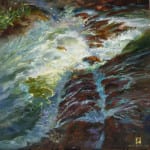
Artworks have the capacity to convey a positive message, to reveal the truth of the unseen, to describe beauty, to define the good that still exists, to communicate between cultures and without spoken language, and to heal. Perhaps that is why occupying armies frequently seek to destroy first the artworks of those they wish to vanquish—to immediately banish beauty, order, and hope in the good from the oppressed.
But each working artist that believes in the power of Art to convey the good is like a Florence Nightingale on the battlefield, among the tents where the wounded lie, going from one victim to the other and ministering to the spirits of those who would otherwise lose hope. Grace and strength will always win out over malice and wickedness. There is power in benevolence, and hope in the sight of the loveliness of a creative spirit. Art that expresses the truth in kindness and gratefulness will disarm the rage, and advance the welfare of all who see it.
As artists, we can do good, and strive to create great artworks. To create at the highest level is a victory over all who would strive to destroy.

It’s Just Paint and Canvas

Lines, colors, shapes, usually on a flat rectangular surface: that’s how we most often define “a painting.” As an objet d’art it has perceived value, both inside and out of the marketplace. Often paintings contain little or no moving parts. Precious metals may be employed, but not usually — it’s simply canvas by-the-yard and pigment. The materials of which a painting is made today are not much different than they were thousands of years ago, when early man painted and engraved shapes of animals on cave walls, with crushed plants and vegetable matter for paint, and animal-fat crayons and fingertips for brushes. The technology of paint-making and the variety of painting surfaces have significantly improved since then, but paint is still made of pigments and the surface of a painting is still usually flat. Doesn’t sound that impressive, does it?
“The synthesis of truth and beauty…is the highest and deepest reality.”Ovid

“ We keep our eyes on the things we cannot see: for the things which we can see are temporal; the things that are unseen are eternal.”2 Corinthians 4:18

The artist is the catalyst in this process of Imagineering and revelation. It is through the artist’s eye that new possibilities can be discovered, and comprehended. In fact, former President John F. Kennedy underlined that creative significance: “I see little of more importance to the future of our country and of civilization than full recognition of the place of the artist. If art is to nourish the roots of our culture, society must set the artist free to follow his vision wherever it takes him.” The painter does what the director does for a film, or the composer for a symphony. He or she draws unrelated concepts together, instills pattern, variety and unity, and discloses the essence of an idea. If we look through the painter’s lens, we are treated to a new perspective on reality. The visionary artist is a conductor on the journey to an exotic destination. We begin to understand that here is something higher in that artwork, than just paint and canvas.
“An artist is not paid for his labor, but for his vision.”James Abbot McNeill Whistler
For a painting, it is the experience of the artist expressed therein that is of utmost value. The material nature of the work is quite secondary. A painting that conveys the power of emotion to the viewer is more than “just paint and canvas.” It is the description of a heartfelt concept that has been forged into tangible excellence through a creative process of envisioning and technical facility. It even has the power to change lives. “(Art) has the capacity to penetrate even the most callous skin and to ignite a revolution from within,” as musician Benjamin Moore so eloquently reminds us. Pursuing art with our whole hearts and minds is probably the most civilizing undertaking we can do as artists. “What a privilege it is to be able to take brush in hand and put paint on paper in this troubled world,” is our encouragement from artist Veronica Stensby.
A painting’s value is not in its material nature, as “just paint and canvas.” Rather, it is the vision an artist expresses with those materials that is of value: that slice of heaven, the best of the Best, that idea of the Ideal, that is the central core of both the material and spiritual worth of an artwork.
